Ligue 1’s defending champions, Lille, haven’t been enjoying a stellar title defence campaign this term. Les Dogues ended last season on 83 points, finishing one point ahead of PSG and earning a UEFA Champions League group stage place. While the Northerners currently top their UCL group, in which they’re competing with Austrian Bundesliga champions Red Bull Salzburg, La Liga side Sevilla and Bundesliga side Wolfsburg, they’ve had far less to shout about in Ligue 1 this season. With just 21 points to their name, at present, they occupy 12th place on the table.
On the other hand, Rennes have enjoyed a far more successful campaign. After ending the 2019/20 season in third place and following that up with a sixth-placed finish last season — a campaign in which they struggled after seeing star man Raphinha depart for EPL side Leeds United late in the summer transfer window — Les Rouge et Noir have started their tenure under new manager Bruno Génésio positively. With 28 points to their name, Rennes currently sit in third place — Ligue 1’s final UEFA Champions League qualification spot.
Despite enjoying a far better season than Lille so far, Rennes boss Génésio refused to underestimate Les Dogues in the build-up to Wednesday’s meeting between the two sides, with the 55-year-old stating that: “They’re struggling a bit in the league right now, but you see in the big games — the Champions League notably — that they’re capable of upping their game, so I know that it’ll be a Champions League level against them” and this level of respect for the opponent was justified, as Jocelyn Gourvennec’s side took all three points away from their trip to Rennes’ Roazhon Park this week, with first-half goals from midfield duo Xeka and Renato Sanches proving too tall of a mountain for Rennes to overcome in the end, despite Benjamin Bourigeaud scoring a late consolation goal for the hosts.
This game provided a lot of tactical talking points and in this tactical analysis piece, I provide some analysis of both teams’ strategy and tactics from their recent Ligue 1 clash. My analysis will look into the tactics and strategy that both teams deployed in several phases of the game and ultimately aim to highlight how “struggling” Lille managed to end red-hot Rennes’ 13-game unbeaten run in all competitions.
Lineups
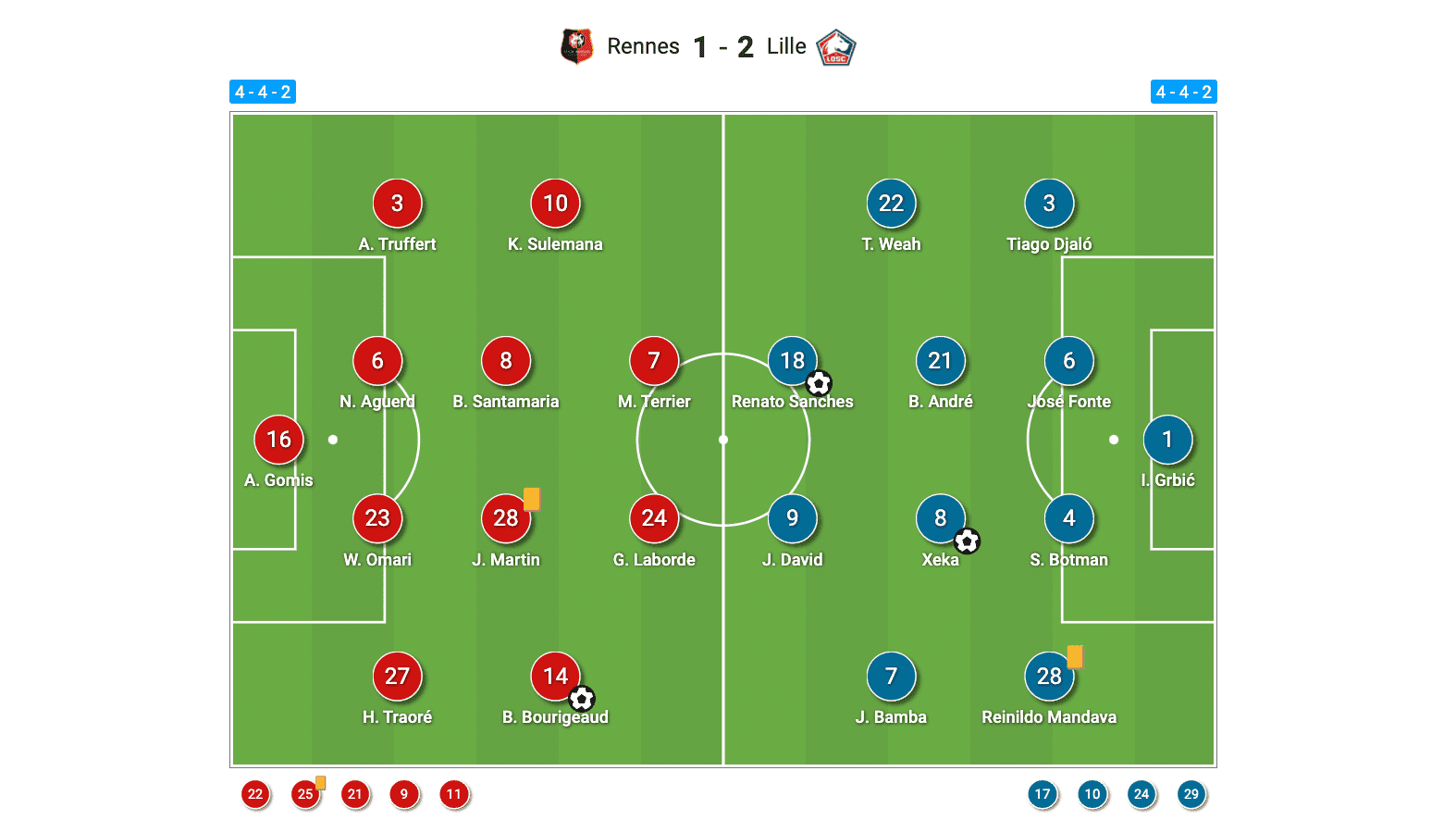
Figure 1 shows both teams’ respective lineups from this game, as portrayed by Wyscout. Both teams started in a 4-4-2 shape, as shown here. However, as the game progressed, Rennes were often seen in more of a 4-2-3-1 shape, with one of their two strikers often dropping deeper. Meanwhile, Lille switched from the 4-4-2 we see above to a 4-1-4-1 from roughly the 20th minute of the game, with Renato Sanches dropping into the midfield line and one of the two central midfielders, either Xeka or ex-Rennes player Benjamin André, dropping into a holding midfield position.
The purpose and effects of these tactical alterations will be discussed in greater detail as we progress through this tactical analysis piece.
Rennes’ starting XI was: GK: Alfred Gomis, RB: Hamari Traoré, RCB: Warmed Omari, LCB: Nayef Aguerd, LB: Adrien Truffert, RM: Bourigeaud, RCM: Jonas Martin, LCM: Baptiste Santamaria, LM: Kamaldeen Sulemana, RCF: Gaëtan Laborde, LCF: Martin Terrier.
Les Rouge et Noir’s first substitution came at the start of the second half when Lovro Majer replaced Terrier; they went on to make a triple substitution in the 60th minute, with centre-forward Serhou Guirassy, left-back Birger Meling, and winger Jérémy Doku replacing Santamaria, Truffert, and Sulemana, before going on to make their fifth and final substitution in the 71st minute, when Lorenz Assignon took over from Traoré at right-back.
As for the away side, Lille’s starting XI was: GK: Ivo Grbić, RB: Tiago Djaló, RCB: José Fonte, LCB: Sven Botman, LB: Reinildo Mandava, RM: Timothy Weah, RCM: André, LCM: Xeka, LM: Jonathan Bamba, RCF: Jonathan David, LCF: Sanches.
Lille made one fewer substitution than Rennes and waited until the 71st minute (when Rennes made their final substitution) to make their first two, with Amadou Onana replacing Sanches in midfield and Jonathan Ikoné replacing David up front. In the 80th minute, Burak Yılmaz replaced Weah (resulting in Ikoné taking Weah’s place out wide and Yılmaz moving into the centre-forward position) and then, in the 92nd minute, Domagoj Bradarić took Bamba’s place, adding some extra defensive solidity to Les Dogues’ shape in order to see out the 2-1 lead in stoppage time.
Lille’s mid-block and defensive organisation vs Rennes’ progression
This season, in all competitions, Lille have kept 48.97% possession on average. Versus Rennes, they kept just 37.77% of the ball. Additionally, while Lille have got an average PPDA of 13.46 for the entire 2021/22 season, their PPDA was 19.48 versus Rennes. This indicates that Lille were happier than usual to play without the ball on Wednesday. They were less careful than their opponents when in possession, while they also pressed far less aggressively than average and than Les Rouge et Noir.
This led to Rennes having more of the ball (62.23%) than average (55.27%) and making more passes (588) than average (482.96), but Lille also limited the Brittany-based side to fewer shots (9) than average (14.56) and lower xG (0.92) than average (1.9). Of course, Lille taking the lead in the 31st minute, increasing it in the 45th minute, and never losing that lead created a certain game state which will have influenced Lille’s style of play and strategy. However, regardless of the reason behind this strategy, they executed it very well.
Les Dogues’ defensive organisation played a key role in their win over Rennes on Wednesday. The reigning French champions didn’t generally press their opponents very aggressively, as is evident from their relatively high PPDA. They did press higher following backwards passes but Rennes didn’t play these a lot in deeper areas, preferring to play a lot of lateral passes at a low tempo before looking to progress. As a result, we rarely saw Lille pressing very high in Wednesday’s game.
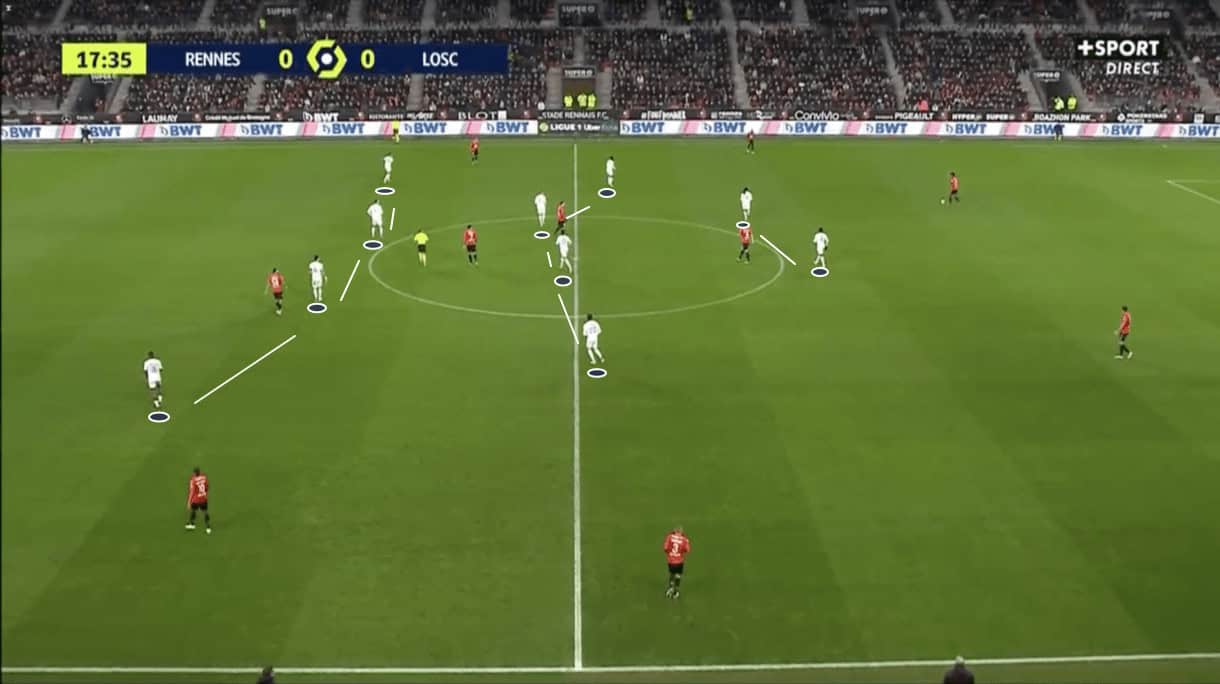
Most of the time, we saw Les Dogues defending in a mid-block like the one we see them deploying here in figure 2. This image is from the early portion of the game during which Lille played mainly in a 4-4-2, and this shape is clearly defined in the image above, as described in the previous section.
Lille’s two centre-forwards were tasked with screening passes into Rennes’ deepest-lying midfielder, both from the centre-backs and from the full-backs if the ball were played out wide in this phase. Meanwhile, Lille’s midfield four and back four remained very horizontally and also vertically compact. The wingers and, to a slightly lesser extent, full-backs defended very narrow and prioritised protecting the centre of the pitch as opposed to retaining access to Rennes’ full-backs/wingers in case the ball were played to them so they could close them down quickly. Quickly closing down was not a key part of their role but preventing the opposition from playing through the lines was, and their compact shape helped them to achieve this.
Rennes didn’t try to force the issue a lot and were generally quite patient with trying to carve their opening through Lille’s midfield. Thanks to the impressive technical ability of Aguerd and Omari, they managed to play plenty of progressive passes into central midfield despite Lille’s excellent shape thanks to their patient approach which focused heavily on progressing through central areas at the expense of going long or directly going through the wings, at times — even when those were viable options. This patient approach also saw Rennes’ backline play a lot of passes between each other in this game while searching for a path for progression, however, and thanks to Lille’s effective shape and organisation, this created some stagnance in Rennes’ play at times too.
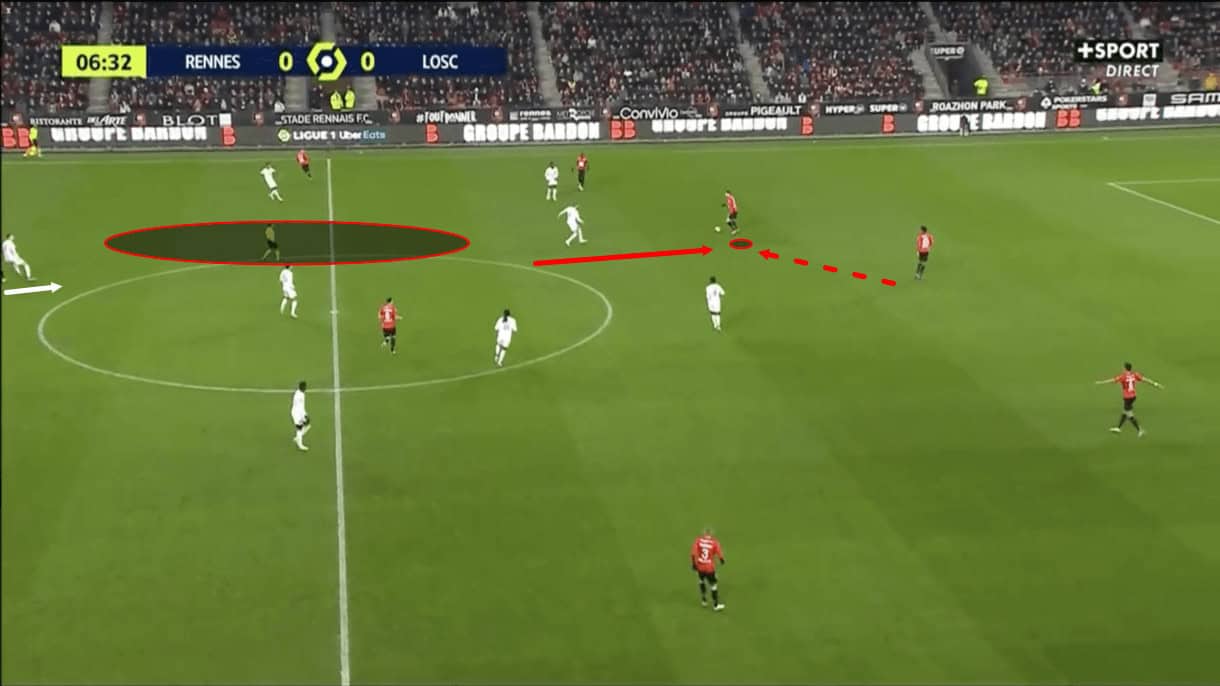
The midfielders and especially the defenders primarily marked zonally but Les Dogues’ central midfielders did get tight to the Rennes central midfielders who occupied their zone and were happy to follow them to an extent. Their constant pressure on these Rennes midfielders made them less attractive passing options than they would otherwise be. Aware of this bit of man-orientation in Lille’s system, Rennes tried to manipulate Lille’s shape in midfield by dropping their central midfielders deep, as we see in figure 3. Les Rouge et Noir’s midfielders were happy to drop deep like this during the ball progression phase as this allowed them to get out of the two centre-forwards’ respective cover shadows and get onto the ball, offering his side a 3v2 advantage over those two forwards in the progression phase.
The movement of Rennes’ midfielders created a dilemma for Lille’s midfielders, as if they allowed them to leave their zone unmarked, this could make ball progression far easier for Rennes but if they followed them out of the zone, this created space behind them. Sometimes, Lille’s midfielders allowed the Rennes men to drop deep unmarked but most of the time, we saw a similar sight to what we see in figure 3, with Lille’s left central midfielder keeping the pressure on Rennes’ right central midfielder after he’s dropped deep.
This helped to prevent a 3v2 from being created in favour of Rennes in this phase but, as previously mentioned and as is highlighted on figure 3, this also created space behind the aggressive midfielder and in front of Lille’s backline, and Rennes looked to exploit this space when it opened up on several occasions in this fixture — it was a clear plan for them to use this movement to create space and play through Lille’s shape.
On this occasion, we see that Lille’s left centre-back, Botman, remained alert to the movement from one of Rennes’ centre-forwards into this space behind Lille’s aggressive midfielder that the ball-carrier could’ve targeted with his pass, and jumped into action to fill the gap that’s been created. This prevented Rennes from playing a dangerous progressive pass into a dropping centre-forward’s feet here and forced Les Rouge et Noir to continue circulating the ball in the backline and trying to forge an opening for progression. This is an example of how Lille’s centre-backs could also be dragged out of position; they had to fill the gaps created by the aggressive central midfielders during the early phases of this game.
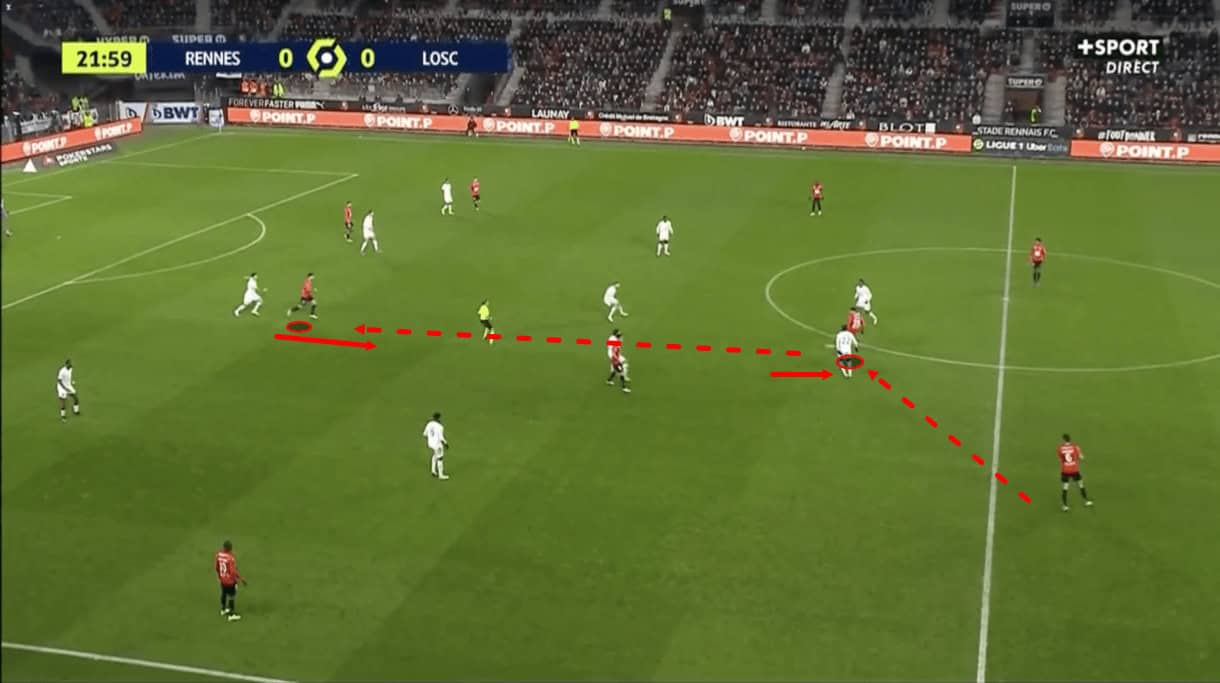
Figure 4 shows an example of another occasion in this game slightly later in the first half when Rennes’ right central midfielder, Martin, dropped deep to receive the ball before turning and exploiting some space that’s open between the lines by sending a pass into the feet of a dropping centre-forward. This highlights Rennes’ intent with this movement; though it didn’t always work, thanks to Lille’s defending, they had a good game plan in mind that could exploit the sometimes man-oriented nature of Lille’s central midfielders and punish it.
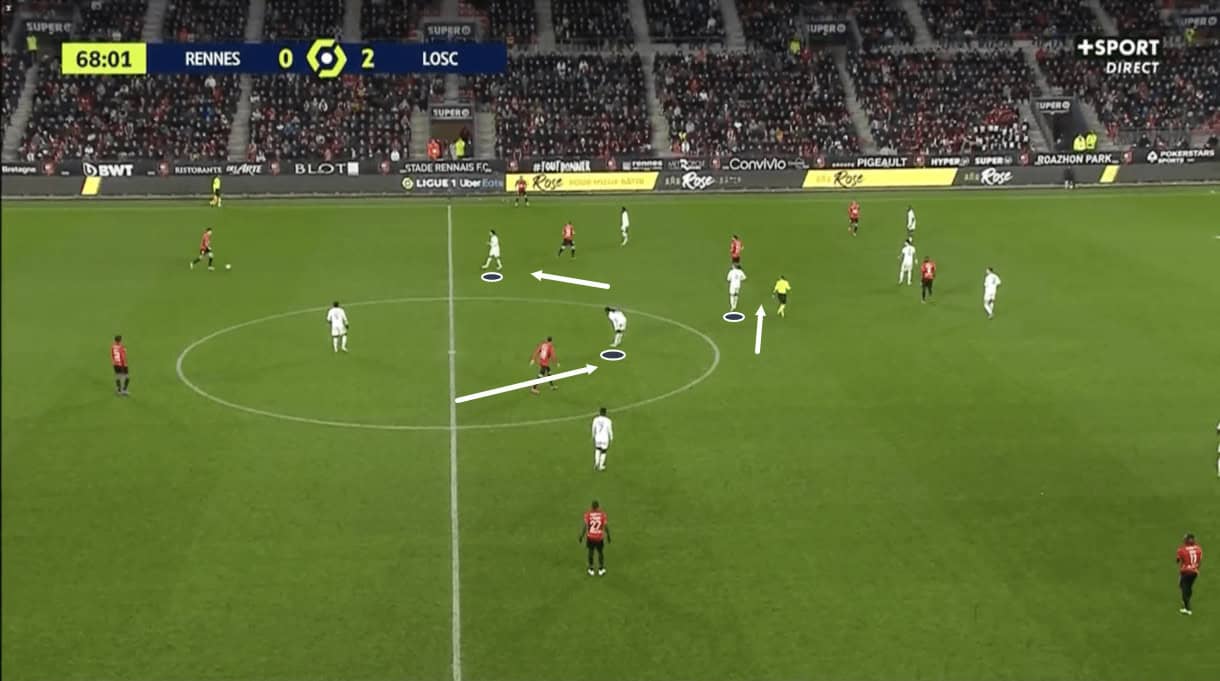
Lille’s switch to a three-man midfield and the 4-1-4-1 shape, which we see in action in figure 5, helped them to protect against this tactic of Rennes’. With Sanches dropping deep, he was now positioned behind one of Rennes’ midfielders rather than in front of them, leaving the other centre-forward solely responsible for the job they were previously doing together — screening passes into midfield.
This change beefed up Lille’s midfield and meant that even if both of Rennes’ central midfielders dropped deep in the progression phase, There would still be one behind them protecting space that could open up in between the lines. With one of Rennes’ centre-forwards often dropping off in between the lines to exploit space — essentially forming a 4-2-3-1 — the 4-1-4-1 allowed Lille to guard against central overloads. Rennes did attempt to double-up on Lille’s deepest holding midfielder on a couple of occasions by dropping both centre-forwards and forcing an overload that way, but Lille’s compact shape and the pressure on the deeper Rennes midfielders still made this very difficult for them to pull off and they ultimately failed to do this effectively in the game, although it wasn’t a bad idea; they were just playing against a very well organised side.
The decision to switch to a 4-1-4-1 was arguably the most influential tactical change that occurred in-game, as this, combined with Lille’s overall compactness, ensured they held their own in the midfield battle versus Rennes.
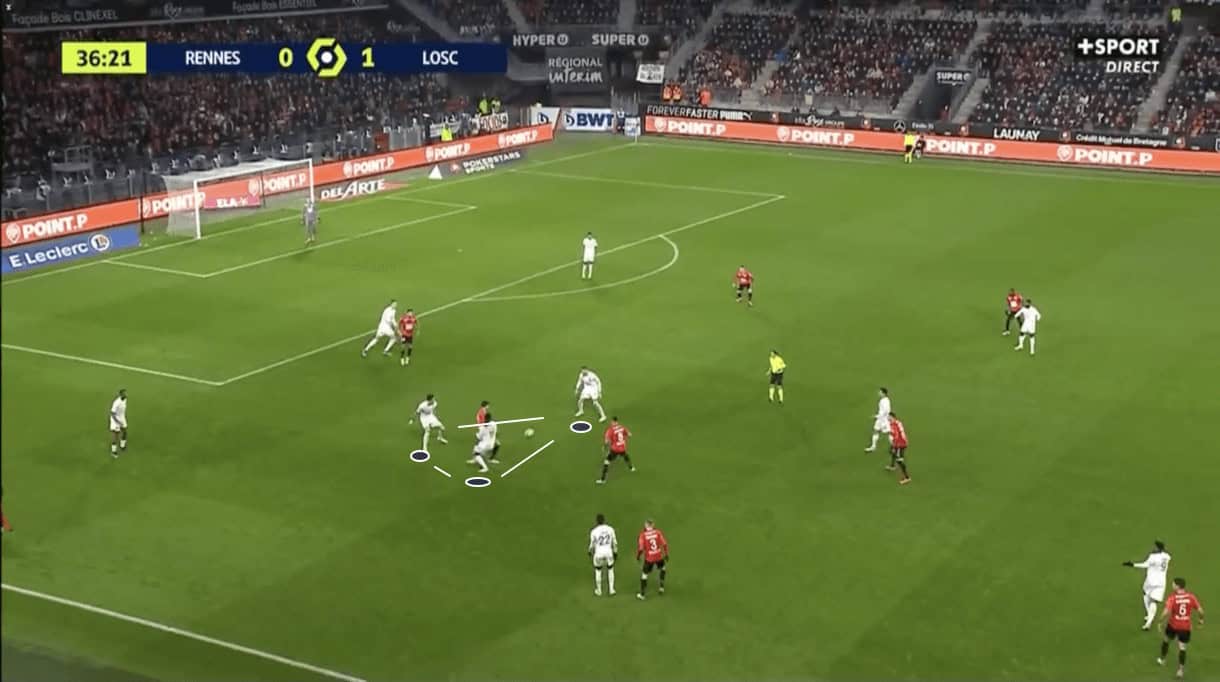
As mentioned previously, Rennes did manage to play plenty of good progressive passes into midfield in this game but, especially after moving to a three-man midfield, Lille did a great job of closing down the ball-receiver on those occasions, hunting for the ball like a pack and if not regaining possession, at least getting it back out of their defensive shape. We see an example of how they did this in figure 6. Just before this image, Rennes sent the ball from deep into the feet of this player in the left half-space. The player received the ball well, thanks largely to his movement and the pass played to him, but before he could really get the ball under control and continue the attack, he was swarmed by Lille shirts and Sanches, now playing as a central midfielder, swiftly dispossessed him.
This highlights the benefit of an extra man deeper in midfield for Lille, but even moreso, this highlights the importance of defensive compactness. Even though Rennes managed to build well from deep into a threatening area of the pitch, Lille were able to snuff out the danger quickly before any significant threat were posed. Even though the Rennes player in the left half-space was able to receive the ball, he was unable to decide and act on his next move in time because he was positioned between three Lille players, all of whom were positioned fairly close to each other. Thanks to this compactness, these players were positioned well to trap the Rennes receiver between them, close him down from several angles, and dispossess him before he had the opportunity to turn. This example shows how compactness made Lille so difficult for Rennes to play through in this game.
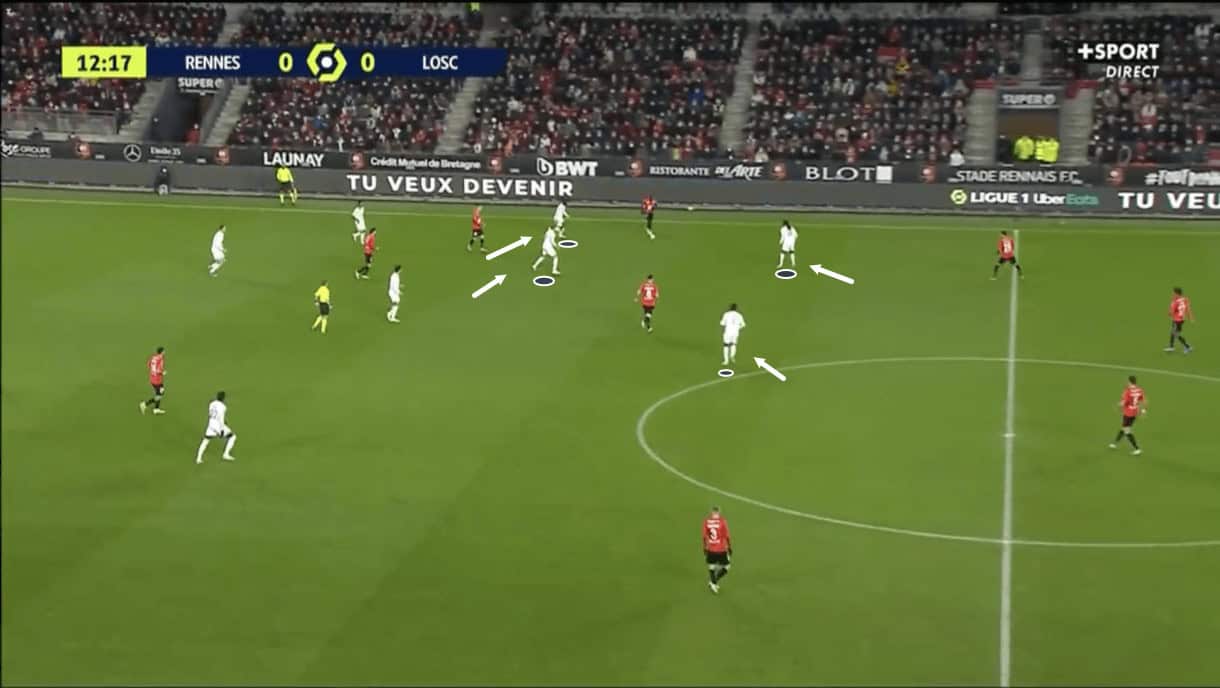
The same benefits were evident for Lille on occasions when Rennes tried to progress via the wings. Les Rouge et Noir tried this on occasion but after first circulating the ball patiently amongst each other in the backline and allowing Lille to settle into their shape, it generally resulted in the sight we see in figure 7. Rennes did have some joy progressing via the wings on occasion, as Lille’s system allowed space to be free on the wings in favour of protecting the centre. However, most of the time, as was the case in figure 7, Lille’s shape adapted to the ball being played out wide, congested space around the receiver out wide, and prevented them from progressing further upfield. In this particular example shown above, Rennes’ right-back was forced to play the ball backwards after Rennes’ midfielders and forwards closed off his best options and continued closing in on him.
Lille deployed a largely position-oriented zonal marking system in both the 4-4-2 and 4-1-4-1 shapes. As mentioned previously, there were some sprinklings of man-orientation in there as well, but for the most part it was position-oriented which allowed them to remain compact, protect the centre, and defend as a unit. Although this left some space out wide, this strategy was successful versus Rennes, who tried to focus a lot of their play through the centre to no avail. Les Rouge et Noir enjoyed some success progressing via the wings in transition but, again, not enough to actually hurt Lille.
Lille in transition to defence
On average, this season, Rennes have had 2.96 counter-attacks per 90, with 39.2% of those resulting in a shot. Had they countered against Lille at this same rate, then they could’ve hurt Les Dogues on the wings where they were weakest, especially when Lille’s centre-back partnership of Botman and Fonte isn’t the quickest centre-back partnership around. However, Lille set up really well to guard against counter-attacks in this game and this successfully limited Rennes to just one counter-attack, which didn’t result in a shot, even if it was a dangerous attack.
Les Dogues’ efficiency at defending against Rennes’ counter-attacks was another major reason for their overall success in this game.
When attacking, Lille’s centre-backs, at least one full-back, if not both, and at least one central midfielder generally stayed deep to guard against potential counter-attacks from the opposition. It wasn’t just the act of staying deep that was important here, however, their organisation and preparation for the opposition’s counter-attack to begin was also important. Lille’s defensive players in the chance creation phase had to be positioned in the best possible place to close down Rennes’ counter-attack threats and kill counter-attacking opportunities before they got going.
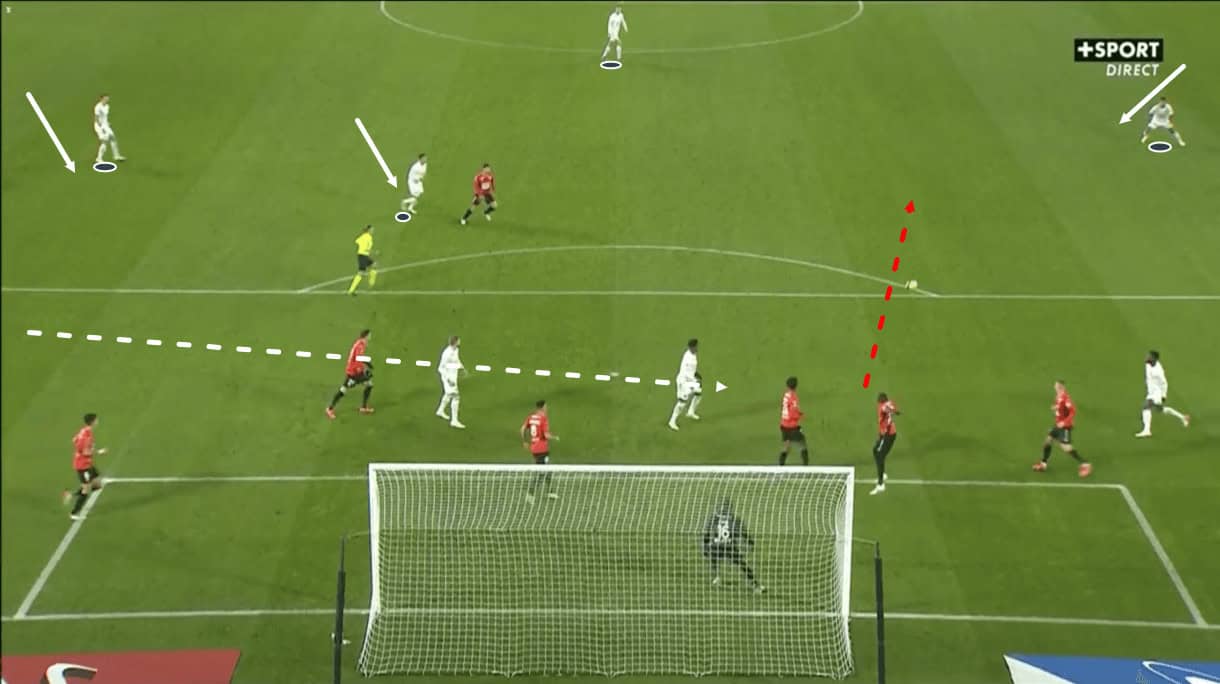
Just before figure 8, Lille’s right-winger, Weah, whipped a cross into the box while five of his teammates (The midfielders, the left-winger, and the forwards) were either supporting him closely for a short cutback on the right-wing or providing a crossing option in the box for him to aim for. Meanwhile, Lille’s two centre-backs and two full-backs remained deep, as we see in figure 8. One centre-back stayed close to the halfway line, one advanced to mark Rennes’ counter-attack threat on the edge of the box, and both full-backs came more centrally, ready to attack the space in front of the counter-attack threat if the ball is cleared into that area.
As play moves on from this, we see Rennes head the ball clear towards the right side of their box. If Lille’s left-back, Reinildo, had been positioned wider or deeper, he wouldn’t be able to get onto this clearance and Rennes’ counter-attack would have legs. However, thanks to his intelligent positioning, the left-back was able to close down the runner and regain possession quickly before he could really control the ball. This didn’t just kill Rennes’ counter-attack attempt, it also helped Lille to sustain their pressure on Rennes’ defence and boost their chances of scoring.
While they didn’t press aggressively, it was very common to see Lille counter-pressing effectively in this game, hence why Rennes failed to create any chances on the counter. The counter-pressing tactics on display in figure 8 and tactics similar to this where the full-backs moved centrally while the centre-backs and sometimes a midfielder too would protect the centre and mark opposition counter-attack threats were effective at making Rennes’ clearances and counter-attack attempts largely ineffective. This is another example of great defensive organisation.
Lille’s switching
While Lille defended with a position-oriented zonal marking system, Rennes defended with a space-oriented zonal marking system. This saw their 4-4-2 / 4-2-3-1 defensive shape get naturally pulled to one side of the pitch very easily. This can be beneficial as it congests space around the ball-carrier out wide, putting extra pressure on this player and potentially denying him a way out, leading to a turnover out wide — an area of the pitch where pressing can be aided by the extra defender that is the sideline.
However, The negative of this system is that it leaves a lot of space open on the opposite side of the pitch for the team in possession to exploit via a switch of play. Lille didn’t make a lot of switches in this game — they didn’t have enough possession to do so — but when they did attack with the ball, they looked to exploit Rennes’ defensive system via their switches often. Les Dogues successfully created plenty of goalscoring chances via switches designed to expose an underloaded flank in this game.
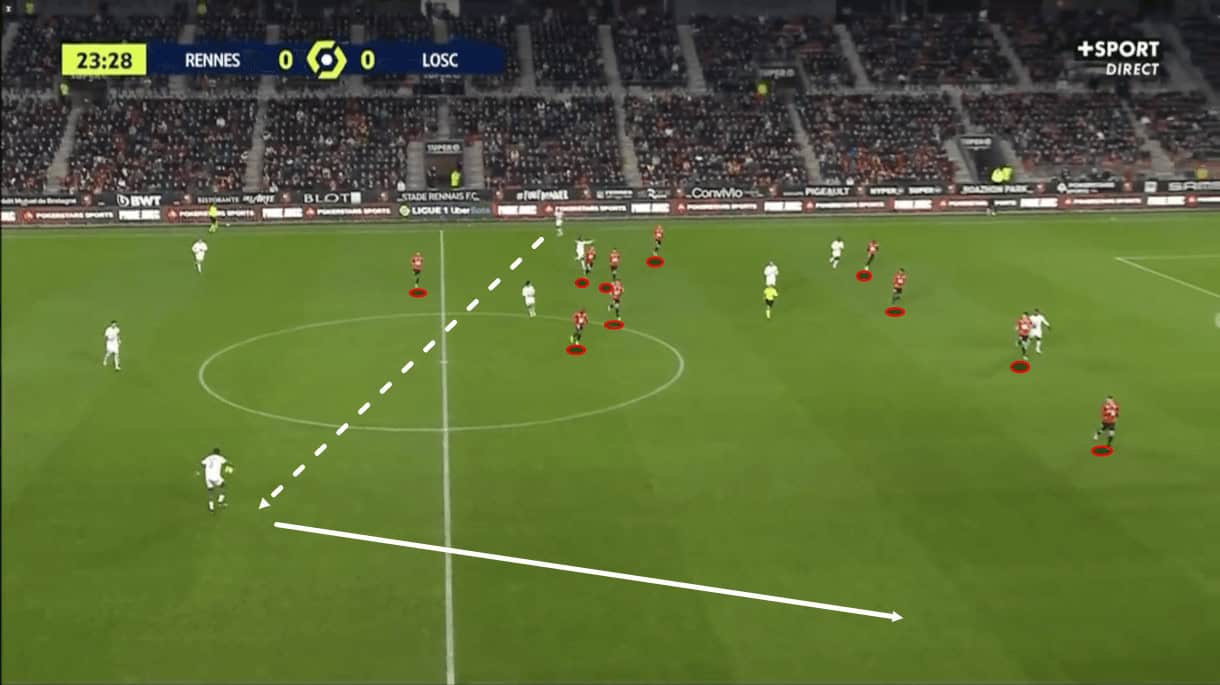
Figure 9 shows an example of Rennes’ space-oriented zonal marking system in action. We can see that while Les Rouge et Noir had congested space on their right-wing around Lille’s ball-carrying left-back, this also left a lot of space open on the opposite wing for Lille’s right-back and right-winger to exploit, which is exactly what happened here. Rennes failed to get close enough to Lille’s left-back to prevent him from making the switch and they left this possibility on display in figure 9 open, which the left-back gladly took. He switched play to the opposite flank, finding Lille’s right-back and creating an opportunity for Les Dogues to quickly progress on the right-wing.
Just out of shot here, higher and wider on the right-wing, was Lille’s right-winger Weah. As play moves on from here, Djaló and Weah combined on the right wing to create a 2v1 against Rennes’ left-back, which resulted in a cross and a goalscoring opportunity. That wasn’t the only instance of a goalscoring opportunity being created for Lille via an intelligent switch in this game. It was a very effective tactic that Les Dogues deployed to take advantage of a clear weakness in their opponents’ marking system.
Lille’s build-up, ball progression and attacking movement
With just 37.77% possession — far lower than their season average of 48.97% — we know that Lille didn’t just spend the vast majority of this game without the ball, but an uncharacteristic amount of time without the ball in this game. We already discussed Les Dogues’ pressing and how that affected their level of possession, but Lille’s strategy in possession and Rennes’ strategy without possession also played a big part in this game playing out the way in which it ultimately did.
Rennes pressed very aggressively in this one, while Lille didn’t play very carefully with the ball unlike their opponents, instead opting to try and force the issue a bit more. Lille were quicker to play risky progressive passes into midfield even when players were under some pressure — which backfired on a couple of occasions — and Lille were also happy to send the ball long over the top in search of a run into the channels from centre-forward David, who was clearly instructed to look for these runs into the channels. Lille wanted to get the ball forward far quicker than Rennes and were definitely the bigger risk-takers on the ball in this game.
Les Rouge et Noir’s aggressive pressing and Lille’s risk-taking nature in possession resulted in Rennes ending this game with a PPDA of 5.63 — much lower than their season average of 10.29 in all competitions. Génésio’s side have been the second-most aggressive team without the ball in Ligue 1, per PPDA via Wyscout, this season though, so this aggression won’t have come as a big surprise to Les Dogues, even if their PPDA suggests they were almost twice as aggressive as normal. Lille had a game plan to combat Rennes’ aggressiveness and executed it very well.
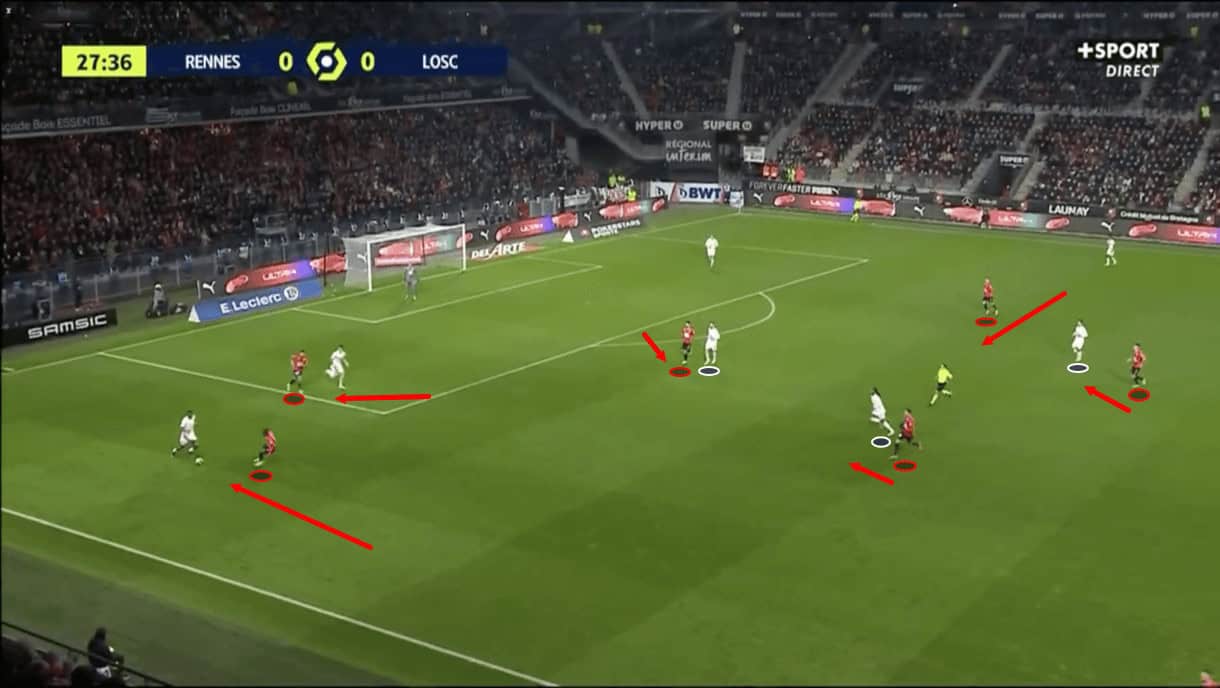
Figure 10 shows an example of Lille building out from the back while Rennes press high. In this particular phase of play, Rennes still operated in a space-oriented press, which is evident from the right-winger who’s in the process of shifting over to the left to congest space around the Lille ball-carrier here, but also got tight to near passing options to block them off from being used.
Just before this image, the ball was sent out to Lille’s right-back Djaló, which was a fairly common sight in this game. Lille’s centre-backs typically came under intense pressure from Lille’s strike partnership when playing out from the back and this often led to the ball moving out to the full-backs, who typically remained quite deep for Lille in build-up, as opposed to pushing higher to provide width. Reinildo did often push high but Djaló always remained deeper and played the role of a ball progressor more than a receiver.
However, as mentioned earlier, full-backs are closer to the sideline which is a dangerous area to be in possession when under intense pressure as was the case here. Thanks to their pressure versus Lille in wider areas, Rennes managed to force a couple of high turnovers in dangerous areas during this game which could’ve resulted in dangerous goalscoring opportunities for Rennes. Lille were fortunate not to be punished for some of their risky play in build-up.
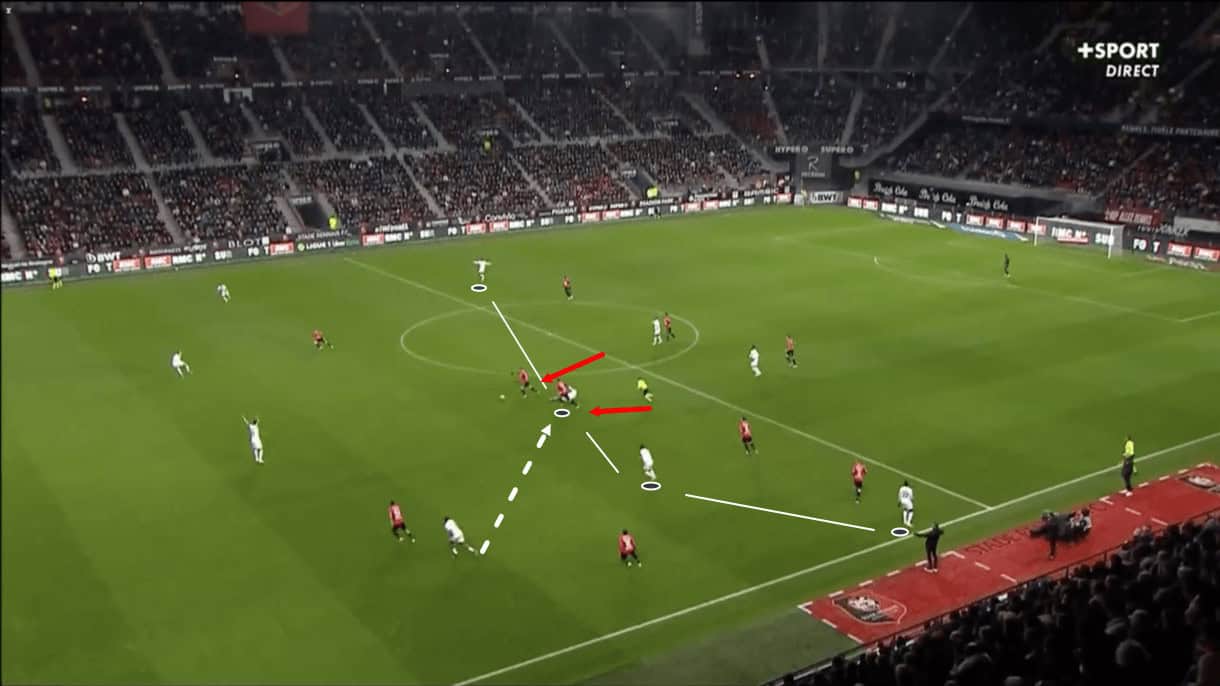
We see one example of Lille’s risky play backfiring in figure 11. Here, Djaló has played a pass into the left central midfielder but with Lille in a wide 4-4-2, the midfielder is easily outnumbered 2v1 by Rennes right central midfielder and right-winger who’ve congested the space on this side of the pitch and close down the intended receiver as soon as this risky pass is played into midfield by Djaló. We see that the Lille man is dispossessed by the Rennes duo and as play moves on from here, Rennes enjoy an opportunity to attack Lille in transition from a very dangerous position, though the attack is ultimately unsuccessful and represents a let-off for Les Dogues.
This example shows 1. The risks of Lille’s high-risk strategy in possession, 2. The benefits of Rennes’ aggressive space-oriented zonal marking system and high press, and 3. The negatives of Lille’s two-man midfield from the early portion of this game in possession phases. If we look back to figure 10, the first image from this section, we can see that this was taken after Lille had switched to the 4-1-4-1 and here, although Rennes are still able to create an overload centrally thanks to their space-oriented system, we see that Lille are at least better prepared to play through their opponents than they were in figure 11, when we see them being seriously dominated in midfield.
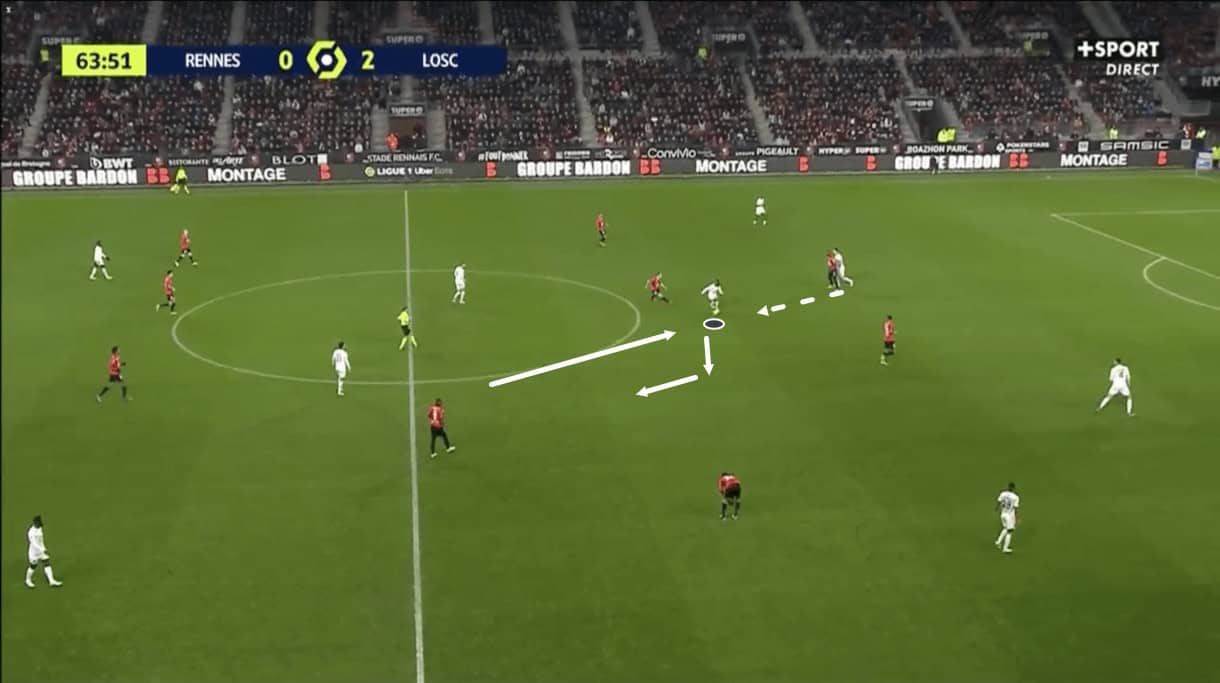
Renato Sanches was the attacker who dropped to become a third midfielder as this game progressed; Lille operated with a degree of positional fluidity and Sanches sometimes found himself on the wing, with one of Weah or Bamba moving into the centre instead, but typically, Sanches acted as the third central midfielder and this suited Lille well, as Sanches didn’t just provide another body in midfield, he provided press-resistance. This press-resistance helped Lille to progress past Rennes’ aggressive central midfield line, as we see in figure 12, as Sanches could receive passes in dangerous areas, turn on the ball and either progress via a pass or just carry the ball forward himself, as was the case in the image above. This was a key part of the Portuguese midfielder’s role which highlights why it was a great bit of in-game management for Sanches — specifically — to drop deeper and improve Lille’s ball progression.
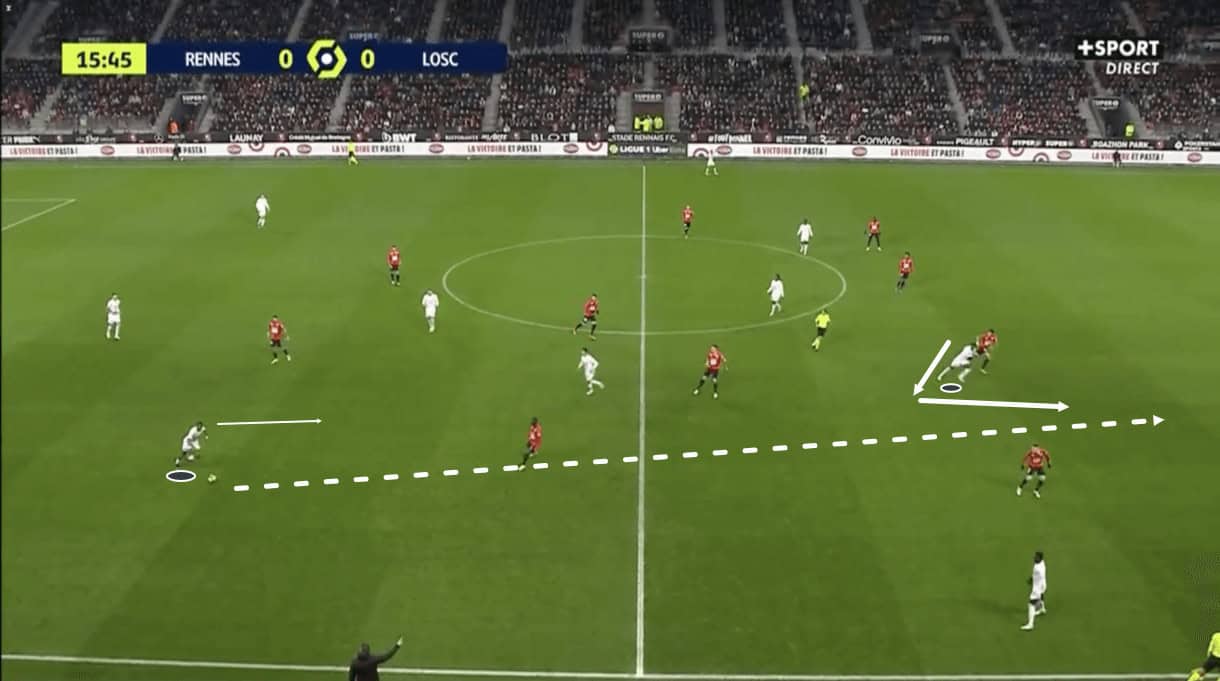
Lille played 51 long passes in this game, which is far more than their average of 40.65 per 90 this season. It was clearly a deliberate part of their tactics to target Rennes’ high defensive line with long balls over the top from the backline — especially Djaló and Botman — in this one, with Canadian forward David constantly making runs into the channels to give these players options. We see an example of one of these runs in figure 13, with Djaló lining up a long ball over the top for David here, which the right-back played well. David’s pace was a clear threat to Rennes’ high line and it made sense for Gourvennec to try and use it to exploit Les Rouge et Noir, even though it didn’t directly lead to a goal. David’s attacking movement was excellent throughout the game, as was his understanding with the centre-backs who were always on the lookout for this run from the 21-year-old attacker.
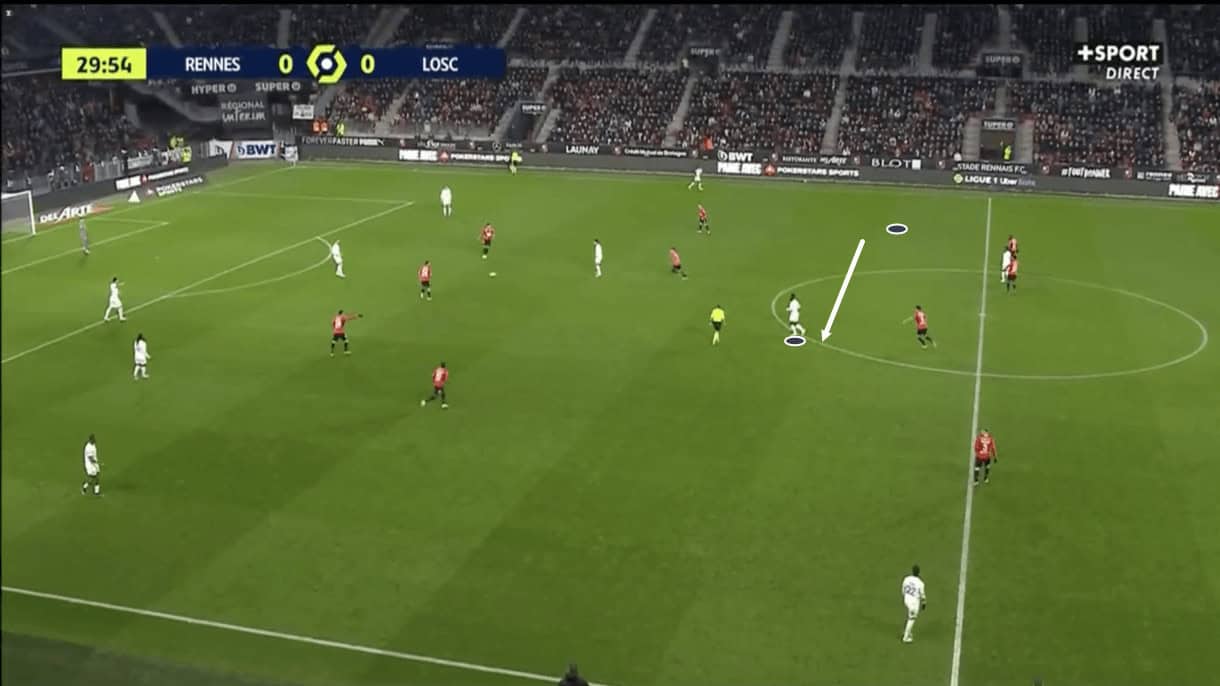
Lastly, figure 14 shows another example of the concept of positional fluidity within Gourvennec’s side in this recent clash with Rennes. Just before this image, the right-winger Bamba was positioned on the right-wing — the position from where he typically defended. However, Bamba enjoyed a lot of freedom on the ball in this fixture and this often resulted in him moving into more of a typical ‘number 10’ position, as we see in figure 14. Bamba could arrive in this position unmarked after losing the right-back who’d normally have been marking him and arriving behind Rennes’ midfielders who would be preoccupied with Lille’s deeper midfield trio. Through his movement, Bamba formed a makeshift tip of a midfield diamond for Lille and enjoyed a lot of space in between Rennes’ midfield and defensive lines.
From this position, Bamba offered his side an excellent progressive passing option in a threatening position, while he also offered some support to David after Sanches dropped into midfield. David could link up with the attacker who moved centrally if he needed someone to combine with and he could also win second-balls from this ‘10’ position, which helped with David being the target of many long balls but not necessarily being the biggest aerial threat.
Thanks to his difficult-to-predict movement, Lille were able to progress plenty of attacks through Bamba and hurt the opposition as a result, with Les Dogues’ second goal coming as a result of this, highlighting how beneficial this degree of positional freedom was for the French champions.
Conclusion
This game was a great tactical battle between two of Ligue 1’s strongest sides (even if the league table doesn’t look too great for Lille at the moment). Gourvennec’s side played an excellent game without the ball, while they also exposed some weaknesses in the opposition’s system very effectively and intelligently to come away with all three points. Lille have their excellent defensive organisation, intelligent exploitation of Rennes’ defensive system, and crucial in-game management to thank for this victory over a Rennes side that had been undefeated for 13 games in all competitions going into this contest at Roazhon Park.





Comments